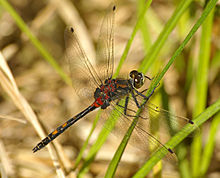| White-faced darter | |
|---|---|

| |
| Male | |
| Scientific classification | |
| Domain: | Eukaryota |
| Kingdom: | Animalia |
| Phylum: | Arthropoda |
| Class: | Insecta |
| Order: | Odonata |
| Infraorder: | Anisoptera |
| Family: | Libellulidae |
| Genus: | Leucorrhinia |
| Species: | L. dubia
|
| Binomial name | |
| Leucorrhinia dubia (Vander Linden, 1825)
| |
The white-faced darter or small whiteface (Leucorrhinia dubia) is a dragonfly belonging to the genus Leucorrhinia in the family Libellulidae, characterised by red and black markings and a distinctive white patch on the head.[2] It is found in wetlands and peat bogs from northern Europe eastwards to Siberia, and the adults are active from around April till September, which is known as the "flight period".[3] It breeds in acidic bodies of water, laying its eggs in clumps of sphagnum moss that provide a safe habitat for larval development.[4] The larvae are particularly vulnerable to predation by fish, and so are usually found in lakes where fish are not present.[5] L. dubia is listed as a species of least concern (LC) by the IUCN Red List, however, it is potentially threatened by habitat destruction, pollution, and climate change.[1]
- ^ a b Boudot, J.-P. & Clausnitzer, V. (2022) [errata version of 2020 assessment]. "Leucorrhinia dubia". IUCN Red List of Threatened Species. 2020: e.T158683A217877630. Retrieved 12 January 2024.
- ^ Brooks, Steve (2018). Field guide to the dragonflies and damselflies of Great Britain and Ireland. UK: Bloomsbury Wildlife. ISBN 978-1472964533. OCLC 1048436611.
- ^ "White-faced Darter". British Dragonfly Society. Retrieved 2019-09-29.
- ^ Henrikson, Britt-Inger (April 1993). "Sphagnum mosses as a microhabitat for invertebrates in acidified lakes and the colour adaptation and substrate preference in Leucorrhinia dubia (Odonata, Anisoptera)". Ecography. 16 (2): 143–153. doi:10.1111/j.1600-0587.1993.tb00066.x.
- ^ Henrikson, Britt-Inger (1988). "The Absence of Antipredator Behaviour in the Larvae of Leucorrhinia dubia (Odonata) and the Consequences for Their Distribution". Oikos. 51 (2): 179–183. doi:10.2307/3565640. JSTOR 3565640.
